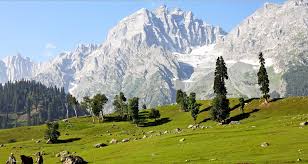 “Where is Sonamarg? All I see is a concrete jungle of bricks and iron.” The remarks by a local visitor summed up the destruction brought by human greed to one of the most sought after tourist destinations of Kashmir called the “meadow of gold”.
“Where is Sonamarg? All I see is a concrete jungle of bricks and iron.” The remarks by a local visitor summed up the destruction brought by human greed to one of the most sought after tourist destinations of Kashmir called the “meadow of gold”.
Situated some 85 km north of the summer capital on the Srinagar-Leh highway, Sonamarg is also home to the Thajiwas glacier — just a half-day but a difficult trek from here.
But that is also shrinking. In fact, “fast vanishing”, according to Shakil Romshoo, a noted Kashmiri earth scientist.
“You will be shocked to know that this is the only glacier in the world where visitors are allowed to drive right up to the base. The heat and pollution coupled with human interference of other kind have been destroying it.”
And down below at Sonamarg, some of the big business houses of Kashmir are building hotels and the destruction in the name of development continues endlessly.
Situated on the banks of the Sindh river that rises in the foothills of the Zojilla Pass in the Baltal area, Sonamarg is taking the kind of environmental beating it might not be able to take for long.
To protect the fragile ecology, the state government has formed a development authority to regulate Sonamarg construction and preserve its ecology.
The officials of the authority say no unlawful construction is allowed and even minor violations, of the approved master plan that has identified green belts and construction sites, are dealt with strictly.
The point is whether a comparatively small hill station should have so much construction even if all of it is lawful.
“Not at all. We should not follow the dangerous course of allowing as many visitors to places like Sonamarg as wish to go there every day,” said Mansha Nisar, who teaches environmental science in a Srinagar college.
“That would be disastrous. We must restrict the number of daily visitors as also the number of hotel accommodations.”
The meadow is witnessing a huge rush of local and outside visitors this season and if the valley security situation remains peaceful more tourists are likely to visit.
Add to this 300,000 pilgrims for the annual Amarnath yatra who use nearby Baltal as the base camp to visit the Himalayan cave shrine dedicated to Lord Shiva.
Some of the yatra load is also borne by Sonamarg since the pilgrims pass through the resort and the more affluent among them spend a day or two here after performing the yatra.
The problem with Kashmir tourist places has been that the state government has remained focussed on the number of tourist arrivals to offset the losses suffered due to separatist violence since late 1980s.
“Regulating the numbers of visitors has been nobody’s priority,” said Nisar Hussain, 64, a retired senior engineer.
“The state government even announces incentives to tour and travel operators who bring in more visitors. Bollywood shooting units are given VVIP treatments with free security cover, official patronage and lunches and dinners to import a semblance of normalcy.”
Hussain said it might have been fine in the past, “but we have to now re-visit the whole situation.
“We owe it to the posterity that they must be able to visit Sonamarg, Gulmarg and Pahalgam and not see them in picture postcards or Bollywood movies in the future.”
The mantra to preserve Kashmir’s tourist and heritage sites ultimately lies in striking a balance between ecology and business. Let the former dictate the rules or else, places like Sonamarg would only hang in photo frames in the drawing rooms of the rich and the famous in near future.




